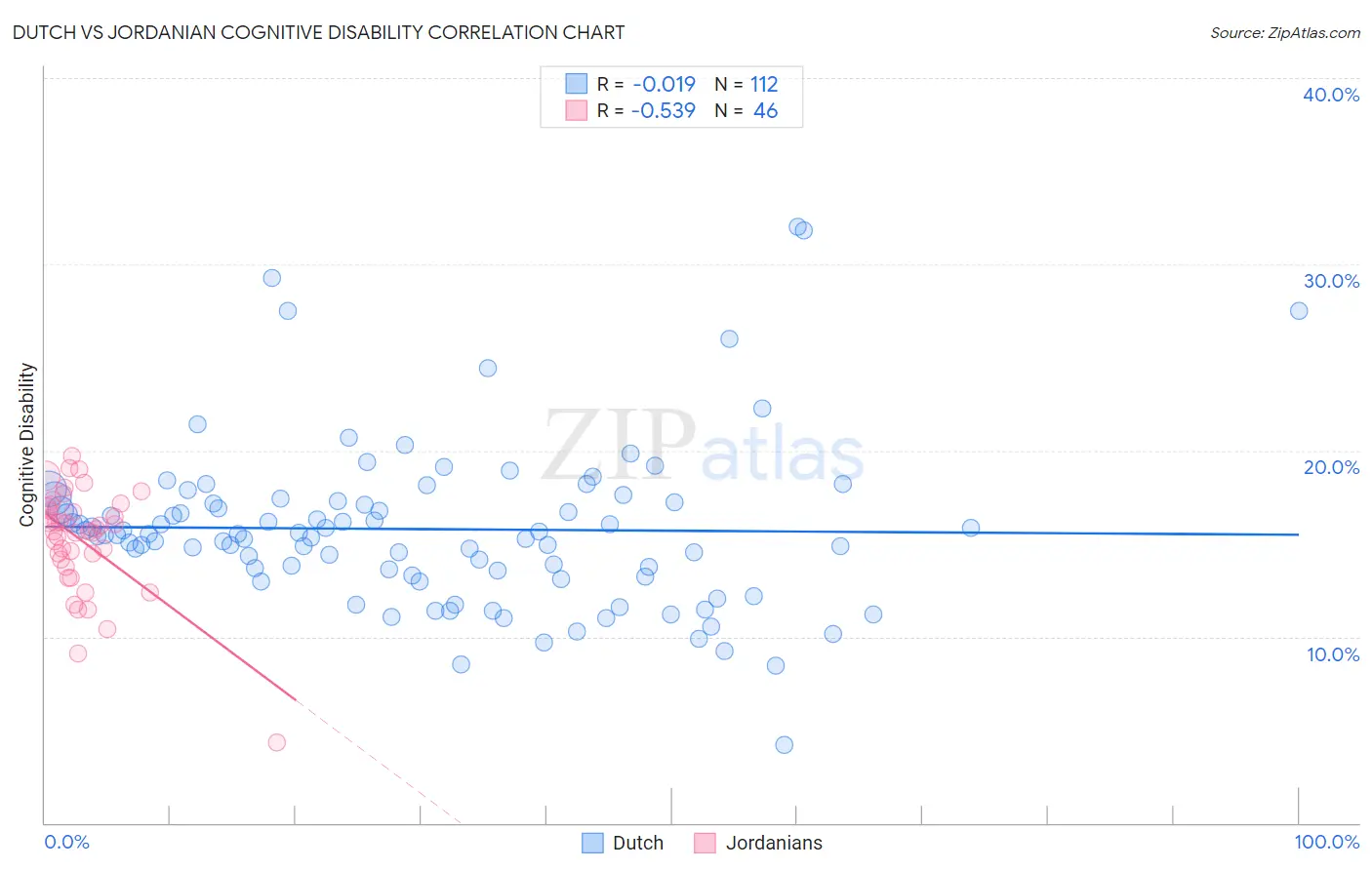Dutch vs Jordanian Cognitive Disability
COMPARE
Dutch
Jordanian
Cognitive Disability
Cognitive Disability Comparison
Dutch
Jordanians
16.8%
COGNITIVE DISABILITY
98.5/ 100
METRIC RATING
97th/ 347
METRIC RANK
16.8%
COGNITIVE DISABILITY
98.2/ 100
METRIC RATING
99th/ 347
METRIC RANK
Dutch vs Jordanian Cognitive Disability Correlation Chart
The statistical analysis conducted on geographies consisting of 554,237,240 people shows no correlation between the proportion of Dutch and percentage of population with cognitive disability in the United States with a correlation coefficient (R) of -0.019 and weighted average of 16.8%. Similarly, the statistical analysis conducted on geographies consisting of 166,416,373 people shows a substantial negative correlation between the proportion of Jordanians and percentage of population with cognitive disability in the United States with a correlation coefficient (R) of -0.539 and weighted average of 16.8%, a difference of 0.11%.

Cognitive Disability Correlation Summary
| Measurement | Dutch | Jordanian |
| Minimum | 4.2% | 4.3% |
| Maximum | 32.0% | 19.7% |
| Range | 27.8% | 15.3% |
| Mean | 15.8% | 15.2% |
| Median | 15.5% | 15.7% |
| Interquartile 25% (IQ1) | 13.4% | 14.1% |
| Interquartile 75% (IQ3) | 17.2% | 16.9% |
| Interquartile Range (IQR) | 3.9% | 2.8% |
| Standard Deviation (Sample) | 4.4% | 2.9% |
| Standard Deviation (Population) | 4.4% | 2.8% |
Demographics Similar to Dutch and Jordanians by Cognitive Disability
In terms of cognitive disability, the demographic groups most similar to Dutch are Finnish (16.8%, a difference of 0.010%), Immigrants from Lebanon (16.8%, a difference of 0.020%), English (16.8%, a difference of 0.040%), Asian (16.7%, a difference of 0.10%), and Immigrants from Southern Europe (16.7%, a difference of 0.14%). Similarly, the demographic groups most similar to Jordanians are Immigrants from Russia (16.8%, a difference of 0.030%), Immigrants from Asia (16.8%, a difference of 0.040%), Irish (16.8%, a difference of 0.060%), Immigrants from Lebanon (16.8%, a difference of 0.090%), and Paraguayan (16.8%, a difference of 0.11%).
| Demographics | Rating | Rank | Cognitive Disability |
| Immigrants | Philippines | 99.0 /100 | #88 | Exceptional 16.7% |
| Immigrants | Egypt | 98.8 /100 | #89 | Exceptional 16.7% |
| South Americans | 98.8 /100 | #90 | Exceptional 16.7% |
| Danes | 98.8 /100 | #91 | Exceptional 16.7% |
| Immigrants | South America | 98.8 /100 | #92 | Exceptional 16.7% |
| Immigrants | Southern Europe | 98.7 /100 | #93 | Exceptional 16.7% |
| Asians | 98.7 /100 | #94 | Exceptional 16.7% |
| English | 98.6 /100 | #95 | Exceptional 16.8% |
| Finns | 98.5 /100 | #96 | Exceptional 16.8% |
| Dutch | 98.5 /100 | #97 | Exceptional 16.8% |
| Immigrants | Lebanon | 98.4 /100 | #98 | Exceptional 16.8% |
| Jordanians | 98.2 /100 | #99 | Exceptional 16.8% |
| Immigrants | Russia | 98.2 /100 | #100 | Exceptional 16.8% |
| Immigrants | Asia | 98.1 /100 | #101 | Exceptional 16.8% |
| Irish | 98.1 /100 | #102 | Exceptional 16.8% |
| Paraguayans | 98.0 /100 | #103 | Exceptional 16.8% |
| Palestinians | 98.0 /100 | #104 | Exceptional 16.8% |
| Immigrants | Eastern Asia | 97.9 /100 | #105 | Exceptional 16.8% |
| Northern Europeans | 97.8 /100 | #106 | Exceptional 16.8% |
| Immigrants | Nicaragua | 97.8 /100 | #107 | Exceptional 16.8% |
| Canadians | 97.5 /100 | #108 | Exceptional 16.8% |